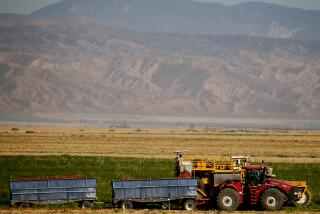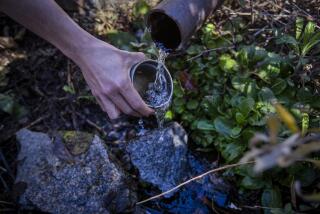Residents Mistrustful of Canadian Developer : Prospect of Huge Colorado Desert Aquifer Sets Off Water Rights Battle
- Share via
ALAMOSA, Colo. — The San Luis Valley, a desert averaging 7 inches of rain a year, may be sitting on one of the continent’s largest aquifers.
And the prospect of a vast underground water supply has set off a fight over how the precious resource should be developed, and by whom.
“The San Luis Valley aquifer probably has more water in it than the Ogallala Aquifer, which provides water for several major agricultural states,” Maurice Strong, founder and chairman of American Water Development Inc., said.
United Against Outsider
“It’s the first time I’ve seen the people of this valley get together and fight something,” said retired water division engineer H. D. McFadden. “That’s because it’s an outsider coming in here to take our water.”
The outsider in question is Denver-based American Water, which wants to drill 97 wells on its 155,000-acre Baca Grant Ranch and pump as much as 200,000 acre-feet a year from the aquifer, or slightly more than 6.5 billion gallons. An acre-foot is enough water to cover one acre a foot deep.
In a December, 1986, application, the company said it wanted the water for “ranch uses” and agricultural projects. When pressed by nervous residents of the valley, it admitted that it eventually would sell the water to thirsty cities like Denver.
Economic Benefits Cited
Company officers say the development will benefit the valley, creating jobs and encouraging new industries. The company maintains in its application that the aquifer is so big that it can support current claims plus new projects.
“It’s a very major resource for the valley and for us,” said Strong, a Canadian, who insisted he was speaking as an interested individual, not company chairman.
The venture is opposed by virtually everyone with a stake in the valley’s current water rights system. The case could be heard as early as this fall in Division Three water court, a specialized state court, in Alamosa.
The San Luis Valley, in which a mere 41,000 people are scattered across 8,200 square miles, gets its water from the Rio Grande and its tributaries and from underground water that runs off the San Juan and Sangre de Cristo mountains.
The complex system of water rights centers on the Closed Basin Project, a federal project begun in the 1970s to help Colorado meet obligations to New Mexico and Texas under the Rio Grande Compact of 1939.
Network of Pipelines
The project is a network of shallow wells and pipelines that lower the water table to prevent evaporation and pump about 100,000 acre-feet a year into lakes and wildlife refuges and into the Rio Grande. It covers 2,900 square miles of Alamosa and Saguache counties, including a corner of the Baca Ranch where streams do not run into the Rio Grande.
The Rio Grande Water Conservation District, which sponsors the Closed Basin and represents water users in five of the six valley counties, has led a costly court fight.
Other opponents include the state Division of Wildlife, the Water Conservation Board, the federal bureaus of Land Management and Reclamation, and the Fish and Wildlife and National Parks services. They are concerned about the effects of American Water’s plan on the Closed Basin Project and some marshes in the valley that are home to endangered waterfowl.
U.S. Data Cited
The company cites a U.S. Geological Survey finding that the aquifer holds 2 billion acre-feet of water--about the same as the Ogallala Aquifer. It argues also that the water under Baca Ranch is non-tributary--meaning its levels would not affect water levels in the rest of the valley.
Rio Grande Water Conservation District Manager Ralph Curtis said that the plan could deplete as much as 38% of the Closed Basin Project’s water. And a recent study by the San Luis Valley Water Conservation District says that much of the aquifer water may not be recoverable; it could be alkaline or otherwise contaminated.
McFadden said the valley’s hydrology still is little known, but evidence suggests that all of the water beneath it is connected. Taking 200,000 acre-feet at the Baca Ranch could lower the water table below many existing wells, he said.
Opponents reject a contention by American Water that the state has no jurisdiction over the water because Baca Ranch was a Spanish land grant subject to Spanish law.
Wants Suit Dropped
The company offered in November to drop its application if opponents would withdraw their suit and agree to cooperate on more aquifer studies.
David Robbins, the district’s attorney, said his clients “are willing to discuss but not dismiss.” For one thing, they want court costs.
“There was a lot of hucksterism,” Robbins said. “Mr. Strong and his cohorts in 1986, without word one to anyone in the valley, sprung their claim.
“They forced people in the valley to spend enormous amounts of money finding out about those claims. They have been unforthcoming about what it is they’re going to do and how they’re going to do it.”
Strong became a player in valley issues 11 years ago when he took control of Phoenix-based AZL Resources Inc., which, among other investments, owned the Baca Grant Ranch, near Crestone in the northeastern corner of the valley.
Before that, he had built an international reputation in economic development and environmentalism. He is a Canadian oil developer who made his first million by age 23 and later became the first head of the Canadian International Development Agency and the first executive director of the United Nations Environment Program.
Ex-EPA Chief Involved
Strong formed American Water in March, 1986, with former U.S. Environmental Protection Agency chief William D. Ruckelshaus, Denver Tabor Center developer David Williams Jr., Canadian financier Sam Belzberg, the Pennsylvania investment banking firm RRY Partners and Robert B. Anderson, whose father is Robert O. Anderson, former chairman of Atlantic Richfield Co. Former Gov. Richard D. Lamm joined the board in May.
More to Read
Sign up for Essential California
The most important California stories and recommendations in your inbox every morning.
You may occasionally receive promotional content from the Los Angeles Times.










